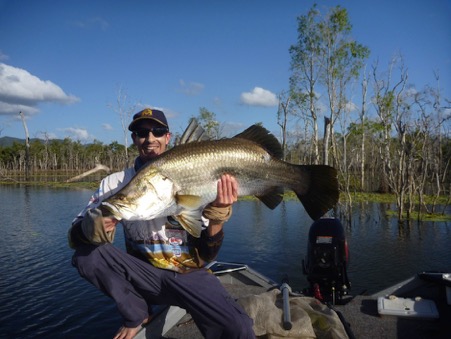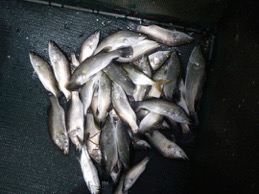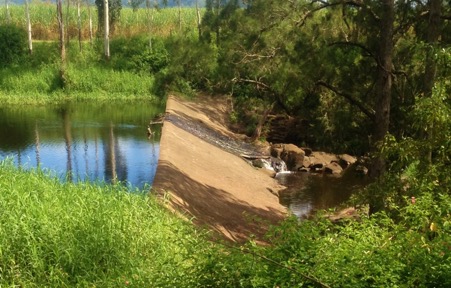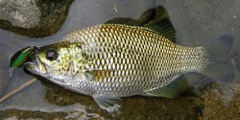From little fish big fish grow…
Oct 4, 2016
It sounds obvious, but it’s a feat of nature few of us witness – small fish need time, uninterrupted access to our waterways and a whole lot of good quality habitat to become the big catch that sends tingles through an angler’s spine. In the quiet of the creeks and rivers, if there’s something getting…

It sounds obvious, but it’s a feat of nature few of us witness – small fish need time, uninterrupted access to our waterways and a whole lot of good quality habitat to become the big catch that sends tingles through an angler’s spine.
In the quiet of the creeks and rivers, if there’s something getting in the way as our juveniles struggle to the next stage of their life, the inevitable result? Far less good sized, healthy fish in our future.
It’s the equivalent of an underwater horror show for keen fishers – the idea that the next generation will have access to a significantly reduced pool of fish stock and diversity. Who wants to sit in a river mouth ten years from now reflecting on the kind of fish you used to be able to catch?
Now is the time to give it some consideration, according to the latest research. A recent report by Queensland based environmental consultants has identified thousands of potential barriers stopping our native fish in their tracks. Both manmade and natural, these barriers are interfering with our native fishes’ ability to manoeuvre through vital water courses to complete their life cycle. It’s a particularly pertinent issue for diadromous (migratory) species who need to transition from salt to freshwater over the years.
We’re talking some big name breeds – depending on your location, barra, mangrove jack, sleepy cod, jungle perch, tarpon, Australian bass, sea mullet, long and short-finned eels to name a few.
 Depleting our waterway health also increases the likelihood of a slow invasion by pest fish who are less sensitive than our natives and who thrive in poor conditions – for example the notorious tilapia, cane toad of the water.
Depleting our waterway health also increases the likelihood of a slow invasion by pest fish who are less sensitive than our natives and who thrive in poor conditions – for example the notorious tilapia, cane toad of the water.
The fish barrier report identified 13,000 potential fish barriers in South East Queensland alone, just the tip of the iceberg. Another report in the Mackay Whitsunday region uncovered 3974 potential in-stream barriers.
While it’s not possible to tackle every barrier, these reports also ranked barriers in order of priority, marking out the top trouble spots to focus on. Here, we introduce you to what fish barriers are and why they matter.
Keep an eye out for part two in this series, which will look at the design and construction of fishways and how we can overcome fish barriers moving forward.

What kinds of fish are being held back by fish barriers?
In particular, diadromous (migratory) species which need to transition between waterways, including salt and freshwater, to complete their life cycle. As previously mentioned, that includes key species like barramundi, mangrove jack, sleepy cod, jungle perch, tarpon, Australian bass, sea mullet and long and short-finned eels.
Many of these much-loved fish species require unimpeded access between freshwater and estuarine habitats to maintain sustainable populations.
If we’re talking scientific terms you can break it down again to:
Diadromous – Diadromous fishes are truly migratory species and whose distinctive characteristics
include that they:
Migrate between freshwaters and the sea;
The movement is usually obligatory; and
Migration takes place at fixed seasons or life stages.
There are three distinctions within the diadromous category:
Catadromous – Diadromous fishes that spend most of their lives in fresh water, and
migrate to sea to breed.
Amphidromous – Diadromous fishes in which migration between freshwater and the sea is
not for the purpose of breeding, but occurs at some other stage of the life cycle.
Anadromous – Diadromous fishes that spend most of their lives at sea, and migrate to
freshwater to breed.
Migrations can vary – some are short and confined wholly to freshwater habitats, while other migrations occur across vast distances and between varying habitats, including between freshwater and near-shore marine environments.
 Our native fish can’t jump
Our native fish can’t jump
Forget the famous images of Atlantic salmon leaping upstream in Canada – our juvenile native fish aren’t even remotely in the same boat. Australian native species are easily knocked back by velocity and brought to a halt by even minor barriers. Historically, Australian waterways have been accessible and they rely on a smooth and comfortable passage between salt and freshwater.
Why they need clear passage
Migration is an essential life history adaptation for many native fish species. Migration strategies between key habitats have evolved for a variety of reasons, including for feeding and reproduction purposes, to avoid predators, remove parasites, to utilise nursery areas and maintain genetic diversity.
Exactly what are fish barriers?
Put simply, fish barriers (natural or manmade) are any barrier deemed to prevent, delay or obstruct fish migration.
Natural barriers can include weed chokes, waterfalls, low dissolved oxygen slugs and high water temperature. Manmade barriers however are more common.
Culprits include culverts, pipes, road crossings, weirs, dams, flow gauging structures, bunds (or ponded pastures) and sand dams.
These structures can be built for a variety of purposes like irrigation supply, flow gauging and regulation, urban and industrial development, road crossings or simply urban beautification and recreation facilities.
How do they affect our fish?
Barriers impact fish communities in many ways. Some barriers such as high dams form complete blockages. Other structures like culverts present partial or temporary barriers, restricting fish movement during particular flow events. Even small vertical drops downstream of road crossings and culvert aprons are enough to form barriers for many fish, particularly juvenile and small bodied species.
How can we get past them?
Manmade barriers are a great target for intervention and remediation works like fishways, which are increasingly seen as the way forward to sustain our native stocks into the future – more on this to come in part two!
Information taken from the: Mackay Whitsunday Fish Barrier Prioritisation Report and the Greater Brisbane Urban Fish Barrier Prioritatisation Report. For more information contact Matt Moore, info@catchmentsolutions.com or www.reefcatchments.wpengine.com/cs/resources